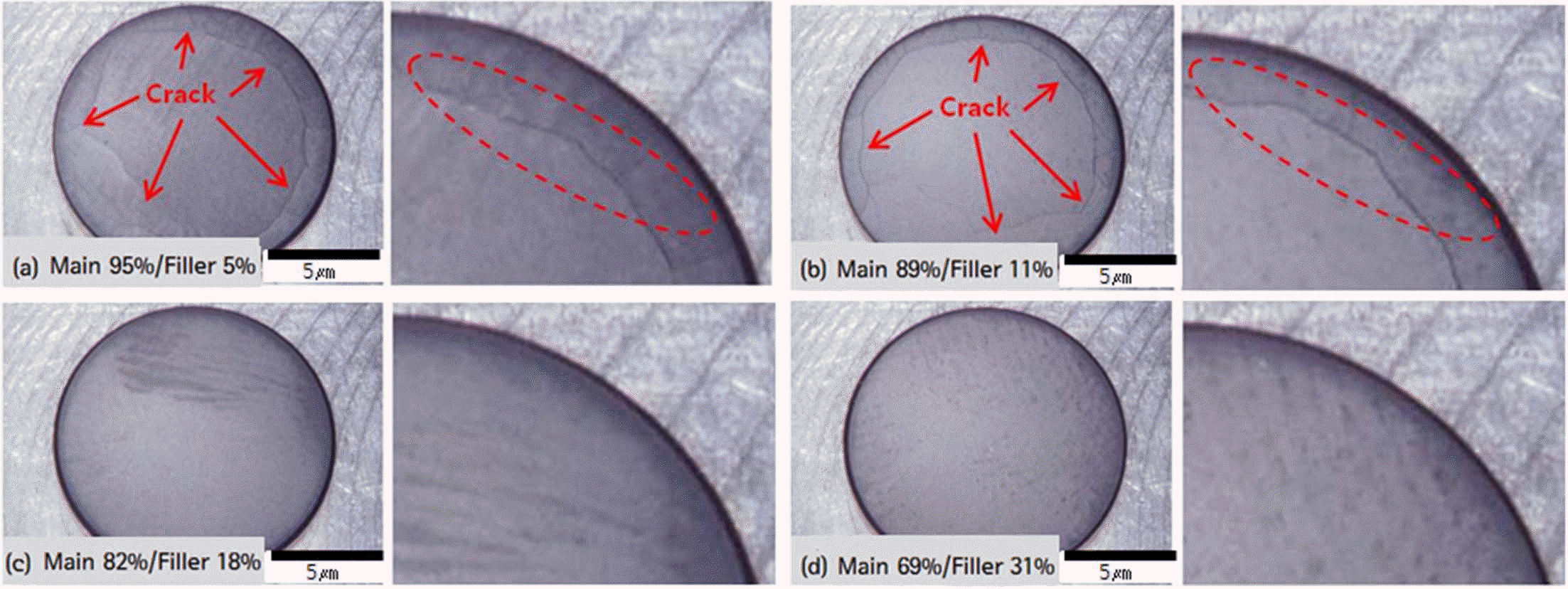Search
- Page Path
- HOME > Search
- [Korean]
- Effect of Molding Pressure on the Microstructure and Wear Resistance Property of Polycrystalline Diamond Compact
- Ji-Won Kim, Hee-Sub Park, Jin-Hyeon Cho, Kee-Ahn Lee
- J Korean Powder Metall Inst. 2015;22(3):203-207. Published online June 1, 2015
- DOI: https://doi.org/10.4150/KPMI.2015.22.3.203

- 764 View
- 7 Download
- 2 Citations
-
 Abstract
Abstract
 PDF
PDF This study investigated the microstructure and wear resistance property of HPHT (high pressure high temperature) sintered PDC (polycrystalline diamond compact) in accordance with initial molding pressure. After quantifying an identical amount of diamond powder, the powder was inserted in top of WC-Co sintered material, and molded under four different pressure conditions (50, 100, 150, 200 kgf/cm2). The obtained diamond compact underwent sintering in high pressure, high temperature conditions. In the case of the 50 kgf/cm2 initial molding pressure condition, cracks were formed on the surface of PDC. On the other hand, PDCs obtained from 100~200 kgf/cm2 initial molding pressure conditions showed a meticulous structure. As molding pressure increased, low Co composition within PDC was detected. A wear resistance test was performed on the PDC, and the 200 kgf/cm2 condition PDC showed the highest wear resistance property.
-
Citations
Citations to this article as recorded by- Effect of Co Leaching on the Vertical Turning Lathe Wear Properties of Polycrystalline Diamond Compact Manufactured by High Temperature and High Pressure Sintering Process
Min-Seok Baek, Ji-Won Kim, Bae-Gun Park, Hee-Sub Park, Kee-Ahn Lee
Korean Journal of Metals and Materials.2020; 58(7): 480. CrossRef - Enhanced wear resistivity of a Zr-based bulk metallic glass processed by high-pressure torsion under reciprocating dry conditions
Soo-Hyun Joo, Dong-Hai Pi, Jing Guo, Hidemi Kato, Sunghak Lee, Hyoung Seop Kim
Metals and Materials International.2016; 22(3): 383. CrossRef
- Effect of Co Leaching on the Vertical Turning Lathe Wear Properties of Polycrystalline Diamond Compact Manufactured by High Temperature and High Pressure Sintering Process
- [Korean]
- Effect of Diamond Particle Ratio on the Microstructure and Thermal Shock Property of HPHT Sintered Polycrystalline Diamond Compact (PDC)
- Ji-Won Kim, Hee-Sub Park, Jin-Hyeon Cho, Kee-Ahn Lee
- J Korean Powder Metall Inst. 2015;22(2):111-115. Published online April 1, 2015
- DOI: https://doi.org/10.4150/KPMI.2015.22.2.111

- 902 View
- 10 Download
- 3 Citations
-
 Abstract
Abstract
 PDF
PDF This study investigates the microstructure and thermal shock properties of polycrystalline diamond compact (PDC) produced by the high-temperature, high-pressure (HPHT) process. The diamond used for the investigation features a 12~22 μm- and 8~16 μm-sized main particles, and 1~2 μm-sized filler particles. The filler particle ratio is adjusted up to 5~31% to produce a mixed particle, and then the tap density is measured. The measurement finds that as the filler particle ratio increases, the tap density value continuously increases, but at 23% or greater, it reduces by a small margin. The mixed particle described above undergoes an HPHT sintering process. Observation of PDC microstructures reveals that the filler particle ratio with high tap density value increases direct bonding among diamond particles, Co distribution becomes even, and the Co and W fraction also decreases. The produced PDC undergoes thermal shock tests with two temperature conditions of 820 and 830, and the results reveals that PDC with smaller filler particle ratio and low tap density value easily produces cracks, while PDC with high tap density value that contributes in increased direct bonding along with the higher diamond content results in improved thermal shock properties.
-
Citations
Citations to this article as recorded by- Effects of initial diamond particle size on the comprehensive mechanical properties of PDC
Xueqi Wang, Jianbo Tu, Baochang Liu
Ceramics International.2025; 51(8): 10433. CrossRef - HPHT sintering and performance investigation of PDC with different interfacial geometry substrates for trimodal diamond particle size
Jianbo Tu, Xueqi Wang, Haibo Zhang, Baochang Liu
Ceramics International.2024; 50(11): 19074. CrossRef - HPHT sintering and performance investigation of PDC with high stacking density by dual particle size diamond formulations
Jianbo Tu, Xueqi Wang, Baochang Liu
International Journal of Refractory Metals and Hard Materials.2024; 124: 106802. CrossRef
- Effects of initial diamond particle size on the comprehensive mechanical properties of PDC
TOP
 KPMI
KPMI


 First
First Prev
Prev


